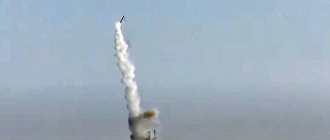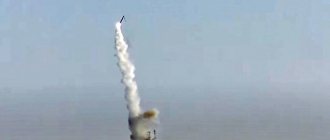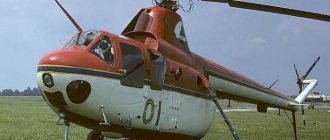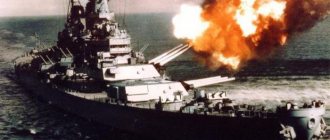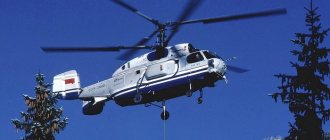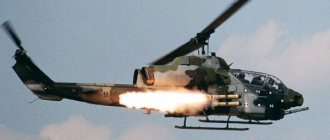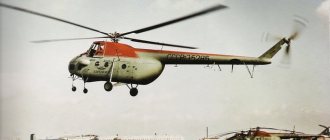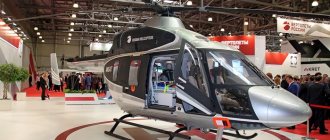In the new millennium, Russian civil aviation is reaching a new technological level, becoming on par with the best foreign developments. This is especially true for the helicopter industry, which is developing at a rapid pace. The emerging new experimental developments of rotary-wing aircraft, the finished latest Mi 38 helicopter, created at the Mil Design Bureau, are real proof of this.
Background to the creation of a new rotorcraft
Back in the early 80s, it became clear in the Soviet Union that the technological resource of the civil aviation helicopter fleet was coming to an end. Despite the fact that the Mi 8 aircraft, available at Aeroflot and other departments, coped with its functions, the country needed a new helicopter. The design of the Mi "eighth" was almost flawless. The successful layout of the helicopter, good avionics and reliable engines ensured this machine a long and productive life. However, time does not stand still. Even such a reliable and easy-to-maintain aircraft as the Mi 8 needed replacement. It was necessary to expand the line of medium helicopters capable of working in a variety of industries.
For the first time, the creation of a new car was discussed at one of the main specialized enterprises in the country. Specialists from the Kazan Helicopter Plant, which was a branch of the Mil design bureau, were able to provide the first sketches and drawings of the helicopter of the future in 1983. A quick glance at the technical documentation made it clear that the new machine would be a fundamentally new aircraft. Despite this, , which was the main customer of the new rotorcraft, placed higher technical requirements on the project.
Until 1987, there was a struggle between design opinions and customer requirements. As a result, the subsequent development of the promising helicopter was moved to the capital, where specialists from the Moscow branch of the Mil Design Bureau took on the development of the project. All work in this direction was headed by A.N. Ivanov.
They first learned about the new Soviet helicopter at the Paris Air Show in Le Bourget, which took place in 1989. Even then it was clear that the USSR would probably be able to create a competitive rotorcraft. It should be noted that at that time the first negative phenomena began to appear in the country’s economy, which inevitably affected the pace of construction of new aircraft. Over the next two years, they managed to create only a full-scale model of the new helicopter, which was presented at the Moscow air show in August 1992. This event took place in a new country. The great aircraft manufacturing power, the Soviet Union, ceased to exist in December 1991.
In the early 90s, during the most difficult period in the history of the development of the helicopter industry, Russian aircraft manufacturers managed to do a lot. In 1993, despite the complete lack of funding for the work, the developers managed to assemble the first two prototypes. From this moment on, slow progress begins towards the creation of a new multi-purpose helicopter for the needs of domestic civil aviation.
New helicopter concept
The new machine, in accordance with the accepted numbering of the design bureau's products, received the designation - the Mi 38 multi-purpose helicopter. For the first time, a domestic aircraft was created with an eye on existing international norms and standards in the field of ecology and flight safety. The construction of a new rotary-wing aircraft has moved the process of introducing certification of helicopter equipment - the domestic analogue of American and European aircraft airworthiness standards - off the ground. The Russian Federation was well aware of the importance of the issue of creating new models of helicopter technology. In order for work to modernize the helicopter fleet and new developments to move faster, a program for the development of the helicopter industry was adopted in Russia.
The helicopter was created for the following purposes:
- transportation of passengers in all variants (“economy class”, “business class”);
- transportation of cargo for various purposes, both inside the cabin and on an external sling;
- operation in a medical and sanitary setting;
- search and rescue version.
The main customer for the multi-purpose helicopter is the Ministry of Civil Aviation. With this machine it is planned to update the helicopter fleet, represented today by the Mi 8 and Mi 17 machines. The older Mi “eighth” machine can be modernized in accordance with new requirements. Similar modernization requirements are being put forward for the Mi 17 helicopter. However, in the case of the new machine, we are talking about a new generation, middle-class helicopter. The flight performance characteristics of the Mi 38 helicopter, which are included in the project, indicate that the machine will surpass all similar models in terms of load capacity, rate of climb, level of technical flight safety and passenger capacity.
The rotorcraft was created with the expectation of subsequent operation in different climatic conditions. The Russian aircraft will have to become the workhorse of civil aviation for high-latitude polar regions, for regions with hot, sea and changeable mountain climates.
The enormous technological potential that the developers have incorporated into the design of the helicopter, combined with a simplified maintenance scheme, allows the machine to have a wider range of operation. Mi "thirty-eighth" is of interest to all departments that, one way or another, are faced with the need for highly mobile air transportation. In terms of automation level, the new Russian aircraft is recognized as the most automated flying complex. Flight navigation equipment will be installed on board the aircraft to ensure automatic flight, including takeoff, landing and hovering at a certain altitude. The vehicle is a promising development, as evidenced by the great interest shown by the military in the Mi 38. In the future, it is planned to use the helicopter for military purposes. A set of radar equipment and a set of weapons for this model are at the development and design stage.
Helicopter "Santa Barbara": Tatar brother-in-law on the Mi-38, Buryat son-in-law on the Mi-171A3
Talk is beginning to come true that the future of KVZ is connected mainly with the Mi-38. Today at MAKS 2021, JSC Russian Helicopters and the Ministry of Emergency Situations of the Russian Federation will sign a contract worth 14.7 billion rubles for the supply of 9 Mi-38 in 2023–2024 Photo: Marina Lystseva/TASS
Expensive and urgent
A megacontract can be called an agreement that will be signed today at MAKS-2021 by JSC Russian Helicopters (VR) and the Ministry of Emergency Situations of the Russian Federation.
According to the contract worth 14.7 billion rubles, 9 Mi-38s are expected to be delivered in 2023–2024, sources in the aviation industry told BUSINESS Online. BP did not comment on this information. The press service of the Ministry of Emergency Situations told BUSINESS Online that “9 Mi-38 helicopters are planned to arrive,” the first in 2023. There are several points worth noting in this contract. The first is its cost. The high cost was initially called the Achilles heel of the Mi-38, they say, the helicopter costs so much that only government agencies can purchase it and it will be difficult for even such wealthy rotorcraft operators as Gazprom and Rosneft to decide to purchase. It is clear that today’s contract implies not only the price per unit, but also some related services, and yet the price is impressive - 1.63 billion rubles per helicopter. For comparison: the Kazan Mi-8 with all the bells and whistles costs more than three times less - approximately 500 million.
As noted in an interview with BUSINESS Online, an expert on helicopter topics, senior researcher at the Academy named after. Zhukovsky Evgeny Matveev , the Mi-38 is even more expensive than the heaviest and largest production helicopter in the world, the Mi-26. Nevertheless, the expert believes: “The cost of the contract is quite real.” At the same time, according to his information, the working aspects of the contract have already been decided and at MAKS there will be only the final stage.
Work on the project began at the Moscow Helicopter Plant named after. Mil (MVZ) in 1988, production of a prototype at KVZ began in 1993, the first flight was scheduled for 1995, and serial production was supposed to begin in 1998. However, the first flight of the Mi-38 took place only on December 22, 2003.
In 1994, Euromil CJSC was created to promote the program. MVZ was responsible for design, ground and flight tests, KVZ was responsible for the construction of prototypes, serial production, sales and support of helicopters in the CIS, Eurocopter (the company was formed in 1992 as a result of the merger of the helicopter divisions of the French Aerospatiale Matra and the German DaimlerChrysler Aerospace; now - Airbus Helicopters) - for flight and navigation equipment, international certification, sales and service in foreign countries. But in 2003, Eurocopter left the Euromile founders.
The big problem was the engines. They decided to install a PW 127/TS from Pratt & Whitney Canada on the helicopter - they did not have their own engines of this class. The first prototype took off with them. It was assumed that up to 500 engines would be supplied to Russia in the form of components, but after the Russian-Georgian war the overseas side, citing organizational changes, backed down. In May 2009, reports appeared that Canadians were leaving the project. A year later, it was announced that future cooperation with Pratt & Whitney Canada was under consideration by the US State Department, which was very concerned that the components would be used on military transport vehicles. In 2013, the engines were never delivered, but then it became known that the only option for the Mi-38 was the TV7-117V engine being developed by the St. Petersburg JSC Klimov.
The basic version of the Mi-38 was certified by the Federal Air Transport Agency in 2015.
Andrei Frolov , an expert at the Russian Council on International Affairs, told BUSINESS Online , it is difficult to assess the adequacy of the cost of one helicopter, since we do not know what the equipment on the sides is. Apparently, she is quite special. According to the press service of the Ministry of Emergency Situations, the Mi-38 will be built in a search and rescue (SR) modification, for flights in the Arctic zone, with the ability to land on icebreakers.
The second point is the fairly short deadline for fulfilling the contract: KVZ will have to do everything in two years. By the standards of the current state of the plant, this is a fairly high pace of construction of new equipment.
This day has been approaching for 30 years: the Kazan Mi-38 will be bought for Putin as well
Let us remind you that the first conditionally serial Mi-38 took off in November 2018, and since then only three aircraft have been delivered to customers. Two Mi-38Ts have been at the disposal of the Ministry of Defense since the summer of 2020. Moreover, according to our sources, they are not flown by the troops, but are still being tested. In February 2020, the Mi-38 with a luxury cabin was handed over to Russian Helicopter Systems, and according to unofficial data, this is on board the Ministry of Industry and Trade of the Russian Federation.
According to sources, today KVZ is making 11 more Mi-38s. Two - for one of the countries of Southeast Asia. Four are VIP helicopters for the Ministry of Defense. Five - for aviation Photo: BUSINESS Online
According to sources, today KVZ is making 11 more Mi-38s. Two - for one of the countries of Southeast Asia. Four are VIP helicopters for the Ministry of Defense: the generals will fly them around the country. Five - for air transporting senior officials.
That is, the workload of the Kazan enterprise for the Mi-38 is hefty, and therefore the information from sources is somewhat surprising that the Ministry of Emergency Situations order for the Mi-38 was moved to an earlier date: initially the start of its execution was planned for 2024, but at the request of the ministry they replayed for 2023. What's the rush? Perhaps the answer lies in the purpose of helicopters. According to the press service of the Ministry of Emergency Situations, in 2024–2026, the Arctic integrated emergency rescue center of the ministry will form aviation units from the Mi-38PS in the Arctic settlements of Sabetta, Dikson, Tiksi, Pevek and Anadyr. It is known what great importance the Russian leadership attaches today to its military and other presence in the Arctic.
Rustam Minnikhanov accelerated preparations for the contract for the Mi-38, and the details were discussed in September 2022 during a visit to the plant by the Minister for Civil Defense and the Ministry of Emergency Situations Evgeniy Zinichev Photo: president.tatarstan.ru
“Mi-8 is no good at KVZ”
The third point is the relatively large number of aircraft for one order for heavy helicopters. At KVZ they have already lost the habit of this. Moreover, the Ministry of Emergency Situations made it clear that nine of these vehicles are just the beginning. “The Russian Ministry of Emergency Situations plans to create aviation links along the entire length of the Northern Sea Route and for this purpose continue to purchase Mi-38 helicopters,” the department says. According to our source, we are talking about 25 aircraft. As Frolov says, one of the government agencies was supposed to fulfill the function of a major launch customer for the Mi-38, and the Ministry of Emergency Situations objectively fits this role. “There are many tasks before the ministry, and new machines are needed.”
Thus, rumors are beginning to come true that the future of KVZ is connected mainly with the Mi-38. As sources and experts have said more than once, the Mi-8/17 topic, as the most stable and profitable, will not be taken away from KVZ (although this is officially denied) in favor of the Ulan-Ude Aircraft Plant (UUAZ).
Opinion
We won’t give up the Mi-8 for another 50 years, but sooner or later they will stop producing it in Kazan. It is already obvious that the Mi-8 has no place at KVZ. The Indian contract for 40 cars will not be concluded, and this was the last hope for the plant for this model. Export contracts now go, as a rule, to Ulan-Ude.
Andrey Frolov expert of the Russian Council on International Affairs
And then, according to one of our interlocutors, UUAZ decided to get into the traditional domain of KVZ - the supply of Mi-8s for the same Ministry of Emergency Situations (in total, Kazan sold about 40 aircraft to the ministry). According to the source, during a recent visit to Ulan-Ude, where a meeting of the board of directors of Russian Helicopters was held, Tatarstan President Rustam Minnikhanov learned that a contract was being prepared between UUAZ and the Ministry of Emergency Situations for the supply of Arctic Mi-8s. Then there was a tense conversation with the leadership of the Ministry of Emergency Situations and BP in the spirit of “this is our topic, give the documentation to KVZ, we will do it.” They claim that the issue came under the close attention of the President of the Republic of Tatarstan after the Army 2020 forum. Allegedly there, Leonid Belykh , who then held the post of managing director of UUAZ, in the presence of the leadership of the Ministry of Emergency Situations, spoke poorly about KVZ and the Mi-38. The information was brought to Minnikhanov, and he accelerated preparations for the contract for the Mi-38, which began already then, and the details were discussed in September 2022 during a visit to the plant by the Minister for Civil Defense and the Ministry of Emergency Situations Evgeniy Zinichev .
The rivalry between KVZ and UUAZ has been going on since the late 90s, when Belykh headed the Buryat plant, and his deputy at that time was Denis Manturov , the current Minister of Industry and Trade of the Russian Federation. Since then they have been closely connected, and as evil tongues say, it is not without reason that UUAZ is always provided with orders, including the most profitable ones.
The apotheosis of the confrontation between Tatarstan and Buryat enterprises was last year’s appointment of Leonid Belykh’s son Alexey (pictured) to the post of managing director of Kazan Helicopter Plant (pictured) Photo: president.tatarstan.ru
The history of the issue is complicated, and there was direct hostility between the Tatarstan and Buryat enterprises. In the mid-2000s, KVZ created an advanced version of the Mi-8 - Mi-8MTV-5, which became the basis of the enterprise’s prosperity, but the Moscow Helicopter Plant, which legitimized changes to the design, transferred all the Kazan developments to UUAZ, which began making exactly the same machine. Then the BP holding, whose creators were the same Belykh and Manturov, completely banned KVZ from improving the G8, so today Ulan-Ude is ahead of Kazan in terms of iron.
“The lag began in 2011, and finally took shape in 2015, when Kazan was banned from improving the G8,” says one of our interlocutors. “But she had her own advanced experimental machine; there was only a ridiculous amount of money left to invest in development work. Banned. Moreover, the idea does not come from Boginsky ( Andrey Boginsky - General Director of BP - editor 's note ), he was not there then, but from Belykh. But Kazan itself is not without sin: it did not really work on either the Mi-38 or the Ansat, it only squeezed the juice out of the Mi-8MTV-5. The prices were prohibitive - for a billion in today's money they were pushing abroad. What else do you need?! Well, the republic missed the situation at the plant.”
“There is a position that everything is fine at KVZ, but Minnikhanov has a different opinion”
The apotheosis of this humiliating story for Kazan residents was last year’s appointment of Belykh’s son, Alexey Belykh . Leonid Yakovlevich himself in June, as prophesied by BUSINESS Online sources, left his post, giving way to his son-in-law, Alexei Kozlov , who previously worked as the financial director of UUAZ (his brother Vyacheslav Kozlov is the financial director of Rosoboronexport). Today Belykh Sr. is an adviser to the general director of BP and, according to our data, oversees the activities of three factories - UUAZ, KVZ and Progress.
The brainchild of UUAZ, the Mi-171A3 helicopter is called the main competitor of the Mi-38 Photo: © Pavel Bednyakov, RIA Novosti
“Killer” Mi-38 from Ulan-Ude?
Interestingly, Kozlov brought to MAKS 2021 a prototype of a helicopter, which is called the main competitor and even “killer” of the Mi-38 - the Mi-171A3. The fact is that the carrying capacity of the Mi-38 is 5–6 tons, the Mi-8 is 4–5 tons. The difference is insignificant, while the Mi-8 has already been tested, costs 3 times less (and the simple version - 4 times) and performs the same functions as the Mi-38. The advantage of the latter is a higher and wider passenger/cargo cabin and the fact that this is a truly modern helicopter that has absorbed all the latest developments, a machine of a different class. That is, the future is still his.
At one time, the Mi-38’s most advanced modernization of the G8, the Mi-171A2 (developed by the Moscow Helicopter Plant, and after its merger with the Kamov company, became the national helicopter manufacturing center), was called a rival to the Mi-38. But one of BUSINESS Online’s sources believes that BP made a big mistake with this car: “It’s like stuffing Gelandewagen guts into a UAZ. It costs a billion, but performs exactly the same tasks as the G8.”
The next call to Ulan-Ude was the Mi-171A3. Frolov recalls that the helicopter is positioned as offshore, but, in fact, we are again seeing intra-company and inter-factory competition. “The Mi-171A3 is positioned as a helicopter for oil workers, but positioning is a tricky business,” the expert notes. “This is where marketers will play.”
The advantage of the Mi-38 is its cabin size and payload capacity. And the Mi-171A3 costs almost the same as the Mi-38 Photo: BUSINESS Online
In terms of size and main characteristics, this is the same Mi-8, but in a new fuselage (by the way, it looks very similar to the smaller Mi-38) and made to the latest standards. Although it does not fly yet, as the source believes, this machine is more technologically advanced and advanced than the Mi-38. “They say that this is the Mi-38 killer, but this is not so,” our interlocutor continues. — The advantage of the Mi-38 is the size of the cabin (and no one wants to walk bent over anymore), and the carrying capacity. It's like comparing a crossover and a full-fledged SUV. And the Mi-171A3 costs almost the same as the Mi-38.” As Frolov clarifies, for the Ministry of Emergency Situations the issue of size is fundamentally important: thanks to the volume of the cabin, the range of standard equipment and transported equipment can be seriously increased, and an “extra” ton of carrying capacity never hurts, for example, for a firefighting helicopter.
As for other potential customers, our source believes that, by and large, everything will depend on the efficiency of the KVZ team. “If we have the same creative and disruptive team as under Lavrentyev ( Alexander Lavrentyev - general director of Kazan Helicopter Plant in 1997–2007 - editor's note ) , things will work out," he is sure. “Potentially, the Mi-38 is the progenitor of a new series of helicopters, but they need to be dealt with as seriously as the UUAZ is with its helicopters.”
So far this seems to be difficult in Kazan. One of our interlocutors spoke about the following episode: when the Ministry of Emergency Situations asked to shift the start of production from 2024 to 2023, KVZ replied that it would not be able to do this. The ministerial officials complained to Minnikhanov. On July 6, the situation was discussed at the plant, for which the financier of the Ministry of Emergency Situations, Deputy Minister Andrei Gurovich, . The matter was on the verge of a scandal. The President of the Republic of Tatarstan almost publicly reprimanded Belykh and his first deputy Vadim Ligai Jr. , saying that you guys don’t want to work, everything is going slowly, and forced them to sign a new schedule.
Our source believes it will be difficult to sustain. “The Ministry of Emergency Situations has many special requests for the car, which require additional tests,” he points out. — There are “childhood diseases” of the engine. However, they will be eliminated, but in general KVZ has not accomplished such feats.”
Design features of the new brainchild of KB Mil
If we compare the rotorcraft with its predecessor, the Mi 17 helicopter, the comparison will be in favor of the former. The crew of the Mi 38 consists of two people. The cockpit is equipped with all the necessary radar and navigation equipment, has good visibility, is spacious and comfortable for long flights. The cargo compartment has two entrances: a side door with a ladder on one side and a cargo sliding door on the other side. Depending on the modification of the machine, a winch with a lifting capacity of up to 300 kg can be installed on it. Loading of large cargo can be carried out through the aft cargo hatch.
At the bottom of the fuselage there is a technological hatch for equipment of the external suspension system. In this mode, the helicopter can lift cargo weighing up to 7 tons into the air.
The propulsion system is represented by two TV7-117V turbofan engines, developed by Klimov OJSC. Both engines are capable of developing a total power of 5000 l/s. In forced mode, Klimov engines are capable of delivering a total power of 7000 l/s.
As for other technical aspects of the rotorcraft design, in this case, the following points should be highlighted.
The helicopter was created according to the classical design - a single-fin fuselage equipped with one main rotor. Six blades are connected to a hydraulic control system, which provides the required angle of attack of the blade during flight. The tail rotor, located at the tail of the car, has a cruciform shape. All blades of both propellers are made of fiberglass. In this case, the designers managed to achieve a balance in the design of the machine, which ensured high aerodynamic data of the helicopter. Instead of using traditional metal cladding made of duralumin to create the fuselage, the designers tried to use composite materials to create the helicopter body. This not only ensured a significant reduction in the take-off weight of the vehicle, but also made the main structural components strong and durable.
The onboard equipment of the Mi 38 helicopter is represented by the latest domestically produced IBKO-38 complex. The main feature of this complex is that with its help the pilots of the aircraft will be able to receive information about the flight in full. In this regard, the safety of operating the machine has increased by an order of magnitude. The entire avionics of the vehicle is controlled by instruments and sensors that provide information about the status of the helicopter’s components and assemblies on LCD screens. Pilots can use the new equipment to make calculations based on the state of the meteorological stop along the route. The operation of the engines is controlled electronically, which makes the piloting process easier for the crew.
The new Russian Mi 38 helicopter is capable of carrying up to 30 passengers. A specialized, converted version of the aircraft can ensure the delivery of 16 injured people to medical institutions. The main flight characteristics of the machine are as follows:
- take-off weight 15600 kg;
- normal load capacity during transportation in a cargo compartment is 5000 kg;
- load capacity on external sling up to 7000 kg;
- rotor diameter 21.1 m;
- fuselage length up to 20 meters;
- cruising speed up to 300 km/h;
- practical range 1300 km;
- working ceiling 3100 m (practical ceiling 5100 m).
Based on all the characteristics, it is immediately clear that the new rotary-wing aircraft is significantly superior to its predecessors, the modernized version of the Mi 8 helicopter and the newer Mi 17 aircraft. Comparing the new Russian helicopter with foreign analogues, we can talk about a product that can adequately represent Russia in the helicopter market. The cost of the Russian model of a multi-purpose helicopter is 15-17 million. For example, the French helicopter AS.332 “Super Puma” costs the French taxpayer 20 million euros. American cars are no cheaper either. In this regard, the Russian Helicopters corporation plans to enter the international market in 2020. The main buyers of the new Russian helicopter may be India, Indonesia, Iran and African countries.
Design features of the Mi-38
The secret of the success of the Mi-8 was the successful choice of the project, which was created with far-reaching growth prospects and future tasks for a middle-class vehicle. After all, the first version of the helicopter had a single engine, but this hardly impressed the customer and the designers came to their senses in time and created a twin-engine version.
The Mi-8 is still in demand in many countries around the world.
The result was unique, the car received excellent payload and passenger capacity and more than sufficient internal volume, unlike its foreign counterparts.
Mi-38 helicopter is not a simple copy of Milev’s “eight” on a slightly larger scale, but a completely new machine, created according to all the rules of the latest requirements on a global scale. The helicopter has large windows used as emergency exits, the fuel system is designed with increased fire safety, and the chassis design is equipped with energy-absorbing shock-absorbing struts that absorb shock loads that occur when falling from a 15-meter height.
The Mi-38 is not just a copy of the Mi-8 in 1:25 scale, but a completely new machine with high capabilities.
Flight comfort in the passenger cabin is ensured by engines located in front of the main gearbox, which, together with elastomeric bearings in the propeller hub and a new transmission, help minimize vibration and noise impacts. The passenger capacity the Mi-38 is 30 people, and the seats have a pitch of 75 cm; the internal volume allows the helicopter to accommodate not only a comfortable toilet, but also a small buffet.
The passenger compartment of the Mi-38 does not have the same vibration and noise as in the Mi-8; it is spacious and comfortable.
On an external sling, the Mi-38 freely lifts and drags 6 tons of cargo, and the vehicle’s carrying capacity allows it to place 5 tons inside the helicopter. It just so happens that in the global market for middle-class helicopters with two engines, only the French Airbus Helicopters H225 can compete with our Russian helicopter.
Only the French H225 helicopter is capable of competing with the Mi-38, but in terms of internal volume it is significantly inferior to the Russian aircraft.
This French helicopter has an excellent payload capacity of 5.5 tons, but the internal space of its cargo compartment is only 15 m3 and this is a military transport version, while the domestic Mi-38 has a cargo compartment volume of 29.5 m3 and can only compete with the same Mi-8.
The current situation with the Mi 38 helicopter
At the moment, there is no talk of starting serial construction yet. The vehicle is undergoing the final stage of testing to ensure reliable operation of the propulsion system. Today, at the helicopter plant in Kazan, the 4th prototype is ready, on the basis of which serial production will be built in the future.
Previously, it was assumed that the helicopter would go into production in 2015, but due to problems with on-board electronic equipment, the plans were disrupted. Despite this, this year the final fate of the car was decided. The military department hastened to conclude a contract with Russian Helicopters JSC for the supply of a small experimental series of the Mi 38 helicopter, ahead of the Ministry of Civil Aviation.
It is planned to transfer the finished vehicles to the military during 2020-2020. The results of flight tests will allow us to draw conclusions about subsequent plans for the purchase of rotorcraft for the needs of the Military Space Forces of the Russian Federation. It is important to note that the latest prototype is a machine entirely assembled by domestic enterprises. The military version of the Mi 38T helicopter is somewhat different from the base machine. Emphasis is placed on improving the transport and cargo compartment and loading and unloading mechanisms. Anti-aircraft protection and night geolocation systems will be added to the existing electronic on-board equipment. Functionally, the created machine will be able to be used in a wide range. This allows for a high technological resource of the helicopter design and ease of maintenance.
Other advantages of the Mi-38
The installation of new rotors, with blades made with a unique profile and entirely made of composites, made it possible to achieve higher speeds and significantly reduce vibration and noise levels.
Excellent aerodynamics and layout of the Mi-38 , design weight perfection and an increased level of engine efficiency ensured the achievement of a maximum ferry range of 1200 km. Western competitors, similar class helicopters AW101 and H225, reached only a range of 1129 and 1135 km, respectively.
Foreign customers are very interested in the cost of operating a helicopter. While the Mi-8 and similar foreign-made vehicles require a crew of two, the Mi-38 can only be controlled by one pilot, and in this he is helped by an integrated diagnostic system, a Russian-made “glass” cockpit and a new navigation system.
The TV7-117V motor can be repaired in the field, since it is manufactured on a modular basis, simply by replacing failed units with serviceable ones. Mi-38 main rotor blades are made of fiberglass and cannot be replaced during the entire service life.
The helicopter can be stored in an open area or airfield; the machine does not require hangar storage. The modern anti-icing system is made quite powerful and allows flights at outside temperatures down to minus 50 degrees. The engines and machine ensure operation at upper temperature limits up to +600 C.
Mi-38 turboshaft helicopter also remains attractive ; the creators undertake to keep it within $17 million, which is quite an advantageous offer for customers, especially compared to machines from Western manufacturers, which cost $20 million and more.
